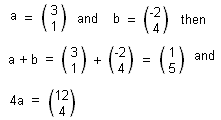Ordered sets
of numbers which can be added by adding the numbers in corresponding
positions, and which can be multiplied by a constant, are known
as vectors. For example, if

In print vectors are usually labeled with letters in bold type as
shown but when writing it is usual to put a squiggle under any letter
representing a vector such as  and
and
 . The number of elements in
a vector corresponds to the dimension of its space, so the examples
shown are 3-dimensional. Vectors can be used to represent changes
of positions and translations. In the diagram, the triangle ABC
has been translated to triangle A'B'C'. Each point
of the triangle has been displaced 3 units to the right and 1 unit
up. An arrow such as PP' is often used on a diagram to represent
the displacement vector.
. The number of elements in
a vector corresponds to the dimension of its space, so the examples
shown are 3-dimensional. Vectors can be used to represent changes
of positions and translations. In the diagram, the triangle ABC
has been translated to triangle A'B'C'. Each point
of the triangle has been displaced 3 units to the right and 1 unit
up. An arrow such as PP' is often used on a diagram to represent
the displacement vector.

Quantities such as acceleration, velocity, force, displacement and
momentum, which have direction as well as magnitude and can be combined
by vector addition, are called vector quantities. In contrast quantities
such as distance, energy and speed, which have magnitude but no
direction, are called scalar quantities.